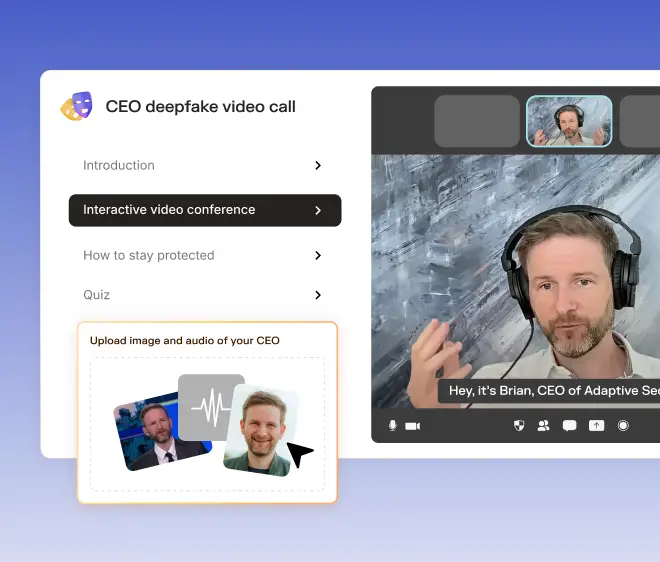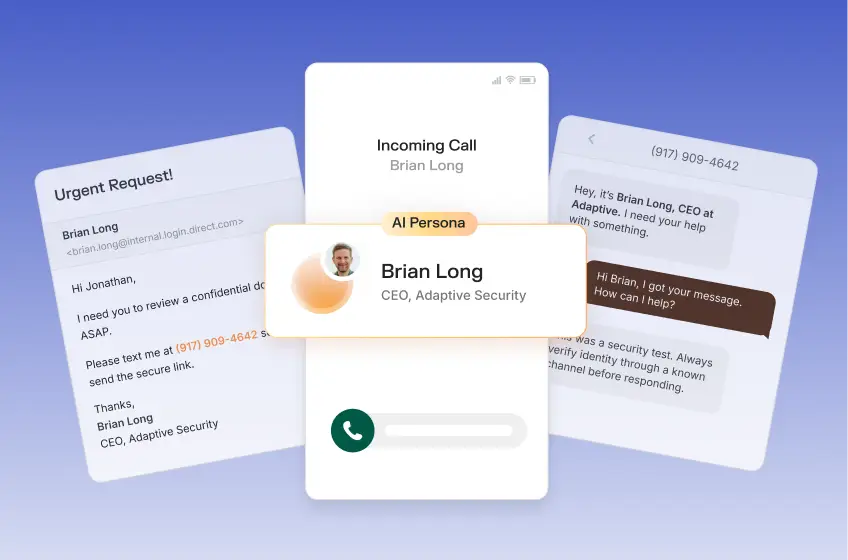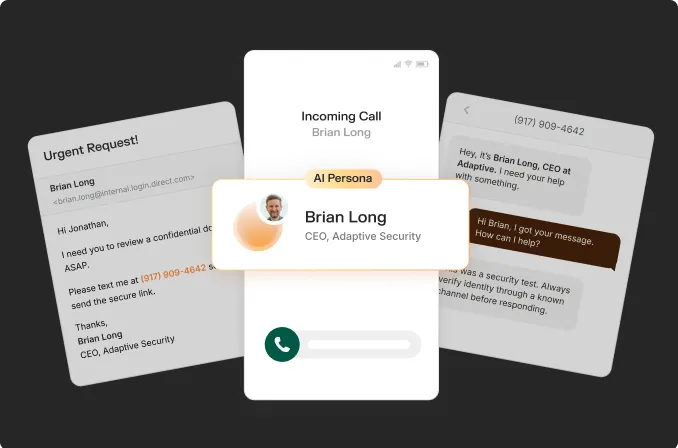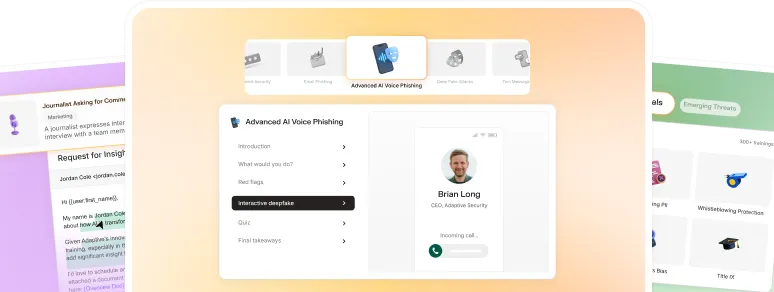Today’s cybercriminals utilize artificial intelligence (AI) to generate hyper-realistic phishing attacks, ranging from indistinguishable deepfakes to emails, text messages, and phone calls that are more sophisticated and harder to detect than ever before.
As the threats facing organizations and their employees evolve, security awareness training can’t fall behind. But the truth is that it already has for many organizations.
Legacy phishing simulations, which rely on static templates and predictable tests, are far from a sufficient defense against attackers who personalize their methods and adapt in real time.
So why not combat phishing attacks powered by AI with training powered by AI?
AI phishing simulations are redefining how organizations train their employees to recognize and respond to social engineering threats across every channel.
Why Traditional Phishing Simulations Fall Short
Phishing simulations through legacy solutions often rely on static, outdated content. But attackers don’t play by the same rules anymore.
Cybercriminals adapt — and personalize. Generative AI tools, such as ChatGPT and Perplexity, have transformed an arduous process into a streamlined task, facilitating the scaling of phishing attacks across multiple channels. It’s why AI phishing is surging.
Traditional phishing simulations, meanwhile, fall short because they’re stuck with several limitations, including:
- Repetitive, outdated templates
- One-size-fits-all delivery
- Limited communication channels, such as email-only
- No personalization for role-based or behavior-based training
To counter today and tomorrow’s threats, phishing simulations need to be smarter, faster, and more authentic. That’s where AI makes the difference, just as it does for the attacks themselves.
What Makes AI-Powered Phishing Simulations Effective?
AI introduces a new level of precision to phishing simulation platforms. Rather than a uniform experience, AI adapts to user behavior, role, and risk profile to deliver personalized, challenging simulations that reinforce training.
Core capabilities of AI-driven simulations
#1. AI-generated phishing content
AI models generate lifelike phishing simulations that evolve in response to real-world tactics. As a result, the ‘attacks’ that employees experience mimic language patterns, brand identities, and context-specific details to increase believability.
Here’s what to expect for impactful AI-generated phishing content:
- Craft messages using natural language generation.
- Replicate sender behaviors and visual branding.
- Stay up-to-date in real-time, based on current events.
Employees shouldn’t find it easy to recognize a phishing test. It should feel difficult to distinguish from a real threat, and this level of realism improves employee vigilance and encourages second-guessing any suspicious communications.
#3. Personalized simulation delivery
Rather than sending the same test to the entire company, AI personalizes phishing attempts by analyzing employee profiles, behaviors, and vulnerabilities. It results in a more targeted and effective training experience.
- Match phishing simulation difficulty to risk level.
- Target different roles with unique content.
- Dynamically adapt to recent user performance.
Users stay engaged and challenged, helping to build stronger, role-specific defenses. It also allows IT and security teams to assign higher-risk phishing simulations to users who’ve already demonstrated proficiency, ensuring continuous skill-building.
#3. Multi-channel testing
Attackers no longer use email alone. AI phishing simulations mimic threats across channels, exposing users to a broader and more accurate range of social engineering attacks.
Here are a few of the types of phishing attacks employees need to be aware of:
- Smishing Attacks: Short for ‘SMS phishing,’ smishing attacks occur through text messages posing as a trusted entity or person.
- Vishing Attacks: A cybercriminal carries out ‘voice phishing,’ phone calls to interact with and deceive an individual into completing a compromising action.
- Deepfake Attacks: Manipulated video and audio trick the target into believing the information shared, often following the false guidance of the impersonated individual(s).
Taking a multi-channel approach to phishing simulations provides employees with a realistic view of how threats can appear anywhere. It also helps IT and security teams evaluate how employees respond to phishing attempts on devices, such as phones, which store both personal and professional data.
#4. Real-time feedback loops
One of AI’s most significant advantages is the ability to deliver feedback instantly. When an employee interacts with a phishing simulation, they’re immediately coached on what went right or wrong, reinforcing learning on the spot.
- Provide on-click feedback and remediation.
- Launch microlearning modules instantly.
- Celebrate correct behavior with positive reinforcement.
Real-time feedback loops make the learning process continuous and less reliant on scheduled sessions. Employees are more likely to remember insights from an interactive moment than from a quarterly video.
#5. Predictive risk scoring
By analyzing click patterns, report rates, and response times, AI identifies users who pose a higher risk to the organization and recommends tailored follow-up training.
- Generate individual and team-based risk profiles.
- Monitor behavior over time to predict trends.
- Flag high-risk employees for further intervention.
IT and security teams can prioritize resources based on real data rather than guesswork, tightening security posture around the most vulnerable employees.
#6. Continuous content updates
Phishing tactics evolve rapidly, and AI continually updates simulation libraries by ingesting threat intelligence and generating new templates that reflect the latest attacks.
- Incorporate global threat intelligence into training.
- Replace outdated scenarios with current threats.
- Automatically tune content to industry-specific risks.
Continuous content updates are particularly valuable in fast-moving or highly regulated industries, such as software, finance, and healthcare, where attackers continually adjust their techniques to obtain sensitive information.
#7. Behavioral analytics dashboards
Beyond individual performance, AI-powered dashboards offer big-picture insights. Security leaders gain clarity on how different roles, departments, and regions perform.
Here’s what that looks like in an effective phishing training platform:
- Aggregate click and report metrics across the organization.
- Display trends, risk movement, and training impact.
- Support exportable reports for compliance audits.
Dashboards simplify audit preparation, improve board-level reporting, and provide visualizations that help justify future AI-powered security investments.
Adaptive Security: Leading the Charge in AI-Powered Training
Adaptive Security sets the benchmark for AI-powered phishing simulations, using open-source intelligence (OSINT) to generate accurate and hyper-realistic simulations.
Backed by OpenAI, the next-generation platform uses artificial intelligence to:
- Generate contextual, hyper-realistic phishing simulations.
- Customize training based on user performance.
- Incorporate deepfake video and voice into simulations.
- Provide intuitive admin dashboards for automated reporting.
- Assist with phishing triage using AI-powered analysis.
Clients throughout every industry — including Podium, Cass Information Systems, and the Dallas Mavericks — praise Adaptive Security for its:
- Modern user interface
- Cutting-edge phishing simulation content
- Fast implementation and setup
- Comprehensive, multi-channel coverage
Blending innovation and usability has made Adaptive Security a top choice among chief information security officers (CISOs) and their IT and security teams. In addition, the platform’s seamless onboarding, numerous integrations, and robust support ensure a quick return on investment (ROI), even for understaffed teams.
Practical Benefits for Security Leaders
So, why should you invest in phishing simulations powered by AI? The answer is simple: Investing in AI-powered phishing simulations brings measurable results.
Below are the benefits every security leader needs to know:
- Reduced employee click rates and incident volume
- Improved threat reporting culture
- Actionable insights for risk management
- Stronger posture for cloud security and financial security
- Enhanced fraud detection through early behavioral warning signs
Every outcome also supports compliance frameworks, such as SOC 2, ISO 27001, and PCI DSS, which increasingly expect proactive training and measurable risk mitigation.
How Much Does Phishing Simulation Software Cost?
Pricing for phishing simulation software varies and can be customized to meet specific needs. However, it typically follows a per-user, per-year pricing model.
For example, pricing may range from $1 per user/ month or $20 per user/year to $999 for up to 50 users per year.
Vendors like KnowBe4, Hook Security, and Infosec IQ may offer tiered pricing. Adaptive Security offers flexible pricing aligned with company size and training needs.
Buyers should also consider what’s included. Some packages offer phishing simulations only, while others combine security awareness training, simulated attacks, and AI-driven reporting in a single platform.
Be cautious of platforms that offer a budget-friendly introductory package as well. Typically, vendors that do this start piling on plenty of add-ons for clients who want access to premium features.
Comparison of leading AI phishing simulation platforms
The Future of Security Awareness is AI-Powered
What’s expected from AI-powered phishing simulations in the future?
As phishing attacks become increasingly sophisticated, traditional training methods no longer suffice. AI-powered simulations prepare employees for the threats of today and tomorrow.
With a next-generation platform like Adaptive Security, organizations gain:
- Human-centric, personalized security awareness training
- Realistic exposure to advanced, multi-channel threats
- Data-driven insights for risk and response planning
AI-driven training doesn’t just improve awareness. It builds an adaptable, stronger security posture through a resilient human firewall that knows how to recognize and respond to threats anywhere they appear.
The moral of the story?
As attackers evolve, your strongest defense layer should too.
Don’t wait for the next breach. Prepare your workforce now with AI-powered phishing simulations from Adaptive Security.




As a technology reporter-turned-marketer, Justin's natural curiosity to explore unique industries allows him to uncover how next-generation security awareness training and phishing simulations protect organizations against evolving AI-powered cybersecurity threats.
Contents









.avif)
.avif)